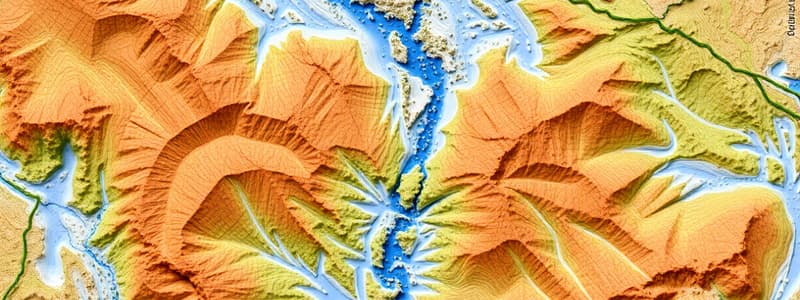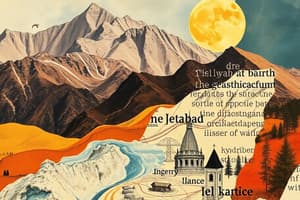Podcast
Questions and Answers
Which of the following processes is most directly associated with the creation of new oceanic crust?
Which of the following processes is most directly associated with the creation of new oceanic crust?
- Erosion by glaciers in polar regions.
- Seafloor spreading at divergent plate boundaries. (correct)
- Subduction at convergent plate boundaries.
- Weathering of continental rocks by acid rain.
Which factor primarily drives atmospheric circulation patterns on Earth?
Which factor primarily drives atmospheric circulation patterns on Earth?
- The gravitational pull of the moon.
- Changes in Earth's magnetic field.
- Variations in ocean salinity.
- Differential heating of the Earth's surface. (correct)
What is the primary difference between physical and chemical weathering?
What is the primary difference between physical and chemical weathering?
- Physical weathering breaks down rocks without changing their composition, while chemical weathering alters their chemical makeup. (correct)
- Physical weathering occurs only in cold climates, while chemical weathering occurs only in warm climates.
- Physical weathering involves the transport of sediments, while chemical weathering does not.
- Physical weathering changes the composition of rocks, while chemical weathering only breaks them down.
Which component of the hydrological cycle is most directly influenced by vegetation?
Which component of the hydrological cycle is most directly influenced by vegetation?
In the context of plate tectonics, what geological feature is commonly associated with a transform boundary?
In the context of plate tectonics, what geological feature is commonly associated with a transform boundary?
How does the greenhouse effect influence Earth's climate?
How does the greenhouse effect influence Earth's climate?
Which of the following is a major factor determining the distribution of biomes across the Earth?
Which of the following is a major factor determining the distribution of biomes across the Earth?
What role do ocean currents play in global climate regulation?
What role do ocean currents play in global climate regulation?
Which of the following natural hazards is most directly related to plate tectonics?
Which of the following natural hazards is most directly related to plate tectonics?
What is the primary focus of pedology as a branch of physical geography?
What is the primary focus of pedology as a branch of physical geography?
Flashcards
Geomorphology
Geomorphology
The study of Earth's landforms and the processes that shape them.
Climatology
Climatology
The study of climate and its variability, including temperature, precipitation, and atmospheric patterns.
Biogeography
Biogeography
The study of the distribution of species and ecosystems across geographic areas.
Hydrology
Hydrology
Signup and view all the flashcards
Earth's Crust
Earth's Crust
Signup and view all the flashcards
Convergent Boundary
Convergent Boundary
Signup and view all the flashcards
Weathering
Weathering
Signup and view all the flashcards
Erosion
Erosion
Signup and view all the flashcards
Climate
Climate
Signup and view all the flashcards
Hydrological Cycle
Hydrological Cycle
Signup and view all the flashcards
Study Notes
- Geography is the study of the Earth's surface, including its physical features, climate, population, and resources
- It bridges the social and physical sciences
- Physical geography focuses on the natural environment
Core Concepts in Physical Geography
- Geomorphology studies Earth's landforms and the processes that shape them
- These processes include weathering, erosion, and tectonic activity
- Climatology is the study of climate and its variability
- It includes analyzing temperature, precipitation, and atmospheric patterns
- Biogeography examines the distribution of species and ecosystems
- It considers factors like climate, soil, and topography
- Hydrology studies water in all its forms
- This includes rivers, lakes, groundwater, and glaciers
- Pedology examines the formation, classification, and mapping of soils
- It considers the physical, chemical, and biological properties of soils
Earth's Structure and Tectonics
- The Earth is composed of several layers: the crust, mantle, and core
- The crust is the outermost layer, divided into oceanic and continental crust
- The mantle is a semi-molten layer beneath the crust
- The core is the Earth's innermost layer, composed mainly of iron and nickel
- Plate tectonics explains the movement of Earth's lithosphere
- The lithosphere is divided into several plates that float on the asthenosphere
- Plate boundaries are sites of earthquakes, volcanoes, and mountain building
- There are three types of plate boundaries: convergent, divergent, and transform
- Convergent boundaries involve plates colliding, leading to subduction or mountain formation
- Divergent boundaries involve plates moving apart, leading to seafloor spreading
- Transform boundaries involve plates sliding past each other horizontally
Weathering and Erosion
- Weathering is the breakdown of rocks at the Earth's surface
- It can be physical (mechanical) or chemical
- Physical weathering includes processes like freeze-thaw and abrasion
- Chemical weathering involves chemical reactions that alter the rock's composition
- Erosion is the removal of weathered material by wind, water, or ice
- Fluvial erosion is erosion by rivers and streams
- Glacial erosion is erosion by glaciers
- Aeolian erosion is erosion by wind
Climate and Atmospheric Processes
- Climate is the long-term average of weather conditions in a region
- Key climate elements include temperature, precipitation, humidity, and wind
- The Earth's climate is influenced by solar radiation, atmospheric circulation, and ocean currents
- The greenhouse effect is the trapping of heat by gases in the atmosphere
- Greenhouse gases include carbon dioxide, methane, and water vapor
- Climate change refers to long-term changes in temperature and precipitation patterns
- Causes of climate change include human activities like burning fossil fuels and deforestation
- Atmospheric circulation patterns are driven by differential heating of the Earth's surface
- These patterns include Hadley cells, Ferrel cells, and Polar cells
- Ocean currents play a crucial role in distributing heat around the globe
- Examples include the Gulf Stream and the El Niño-Southern Oscillation (ENSO)
Hydrological Cycle
- The hydrological cycle describes the movement of water on, above, and below the Earth's surface
- Key processes include evaporation, transpiration, condensation, and precipitation
- Evaporation is the conversion of liquid water to water vapor
- Transpiration is the release of water vapor by plants
- Condensation is the conversion of water vapor to liquid water
- Precipitation is the falling of water in the form of rain, snow, sleet, or hail
- Surface runoff is the flow of water over the land surface
- Groundwater is water stored beneath the Earth's surface
Biomes and Ecosystems
- A biome is a large geographic area characterized by specific climate conditions, animal populations, and plant species
- Major biomes include forests, grasslands, deserts, and tundra
- Forests are characterized by trees and high levels of precipitation
- Grasslands are dominated by grasses and have moderate levels of precipitation
- Deserts are dry regions with sparse vegetation
- Tundra is a cold, treeless biome with permafrost
- An ecosystem is a community of living organisms and their physical environment
- Ecosystems are characterized by the flow of energy and cycling of nutrients
- Food chains and food webs illustrate the flow of energy through an ecosystem
Natural Hazards
- Natural hazards are events that pose a threat to human life and property
- These hazards include earthquakes, volcanoes, floods, droughts, and hurricanes
- Earthquakes are caused by the sudden release of energy in the Earth's crust
- Volcanoes are formed by the eruption of molten rock from the Earth's interior
- Floods are caused by excessive rainfall or the overflow of rivers
- Droughts are prolonged periods of below-average precipitation
- Hurricanes are intense tropical cyclones with high winds and heavy rainfall
Studying That Suits You
Use AI to generate personalized quizzes and flashcards to suit your learning preferences.




